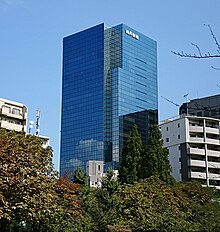|
Kobe Steel
Kobe Steel, Ltd. (株式会社神戸製鋼所, Kabushiki gaisha Kōbe Seikō-sho), is a major Japanese steel manufacturer headquartered in Chūō-ku, Kobe. KOBELCO is the unified brand name of the Kobe Steel Group. Kobe Steel has the lowest proportion of steel operations of any major steelmaker in Japan and is characterised as a conglomerate comprising the three pillars of the Materials Division, the Machinery Division and the Power Division.[3] The materials division has a high market share in wire rods and aluminium materials for transport equipment, while the machinery division has a high market share in screw compressors. In addition, the power sector has one of the largest wholesale power supply operations in the country.[4] Kobe Steel is a member of the Mizuho keiretsu. It was formerly part of the DKB Group, Sanwa Group keiretsu, which later were subsumed into Mizuho. The company is listed on the Tokyo & Nagoya Stock Exchange, where its stock is a component of the Nikkei 225.[5] As of March 31, 2022, Kobe Steel has 201 subsidiaries and 50 affiliated companies across Japan, Asia, Europe, the Middle East and the US. Its main production facilities are Kakogawa Steel Works and Takasago Works.[6] Kobe Steel is also famous as the owner of the rugby team Kobelco Steelers.[7] History In 1905, the general partnership trading company Suzuki Shoten acquired a steel business in Wakinohama, Kobe, called Kobayashi Seikosho, operated by Seiichiro Kobayashi, and changed its name to Kobe Seikosho. Then, in 1911, Suzuki Shoten spun off the company to establish Kobe Steel Works, Ltd. at Wakinohamacho, Kobe.[8] After the Russo-Japanese War, as the Imperial Japanese Navy adopted a policy of fostering private factories, Kobe Steel received technical guidance and orders from the Kure Naval Arsenal and other arsenals in Maizuru and Yokosuka, and expanded its scale.[9] Around 1914, the company started making machinery for naval vessels and began its journey as a machine manufacturer. Its business performance expanded, partly due to the shipbuilding boom during World War I. In 1918, it acquired the rights to manufacture diesel engines from Sulzer of Switzerland, helping to speed up the Japanese naval, marine, locomotive and automobile transport sectors.[10] Today, the KOBELCO Group operates a broad range of business fields that cover Steel & Aluminum, Advanced Materials, Welding, Machinery, Engineering, Construction Machinery, and Electric Power.[11] In the Great Hanshin Earthquake of January 1995, the Kobe head office building and company housing collapsed, and the No. 3 Blast Furnace at the Kobe Steel Works was also damaged, resulting in an emergency shutdown, causing approximately JPY 100 billion in damage, the largest for a private company. The Third Blast Furnace, which restarted only two and a half months after the earthquake, had become a 'symbol of recovery', but was suspended in October 2017 in order to strengthen competitiveness.[12] In recent years, the company has been focusing on fields other than steel, such as aluminium, machinery, and electric power, and is clearly aiming to change from being a 'steelmaker' to a 'manufacturer that also handles steel'.[11] Former prime minister Shinzō Abe worked at Kobe Steel before entering politics.[13] Main locationsSource:[14] Domestic Locations
Overseas Regional Headquarters and Offices
Business Units & Main ProductsSource:[15] Steel & Aluminum
Welding
Advanced Materials
Machinery
Engineering
Electric Power
ScandalIn October 2017, Kobe Steel admitted to falsifying data on the strength and durability of its aluminium, copper and steel products.[13][16] The scandal deepened when the company said it found falsified data on its iron ore powder, which caused its shares to fall 18%. By 11 October, shares had fallen by a third.[13] After testing the parts of their bullet trains, the Central Japan Railway Company announced that 310 components were discovered to contain sub-standard parts supplied by Kobe Steel.[17][18] Following further news in October 2017 that car makers Toyota, Nissan, and General Motors, and train manufacturer Hitachi, were among 200 companies affected by the Kobe Steel's mislabelling, which had potential safety implications for their vehicles, the CEO of Kobe Steel conceded that his company now had "zero credibility".[19] Other affected companies include Ford, Boeing and Mitsubishi Heavy Industries.[13] CEO Kawasaki promised to lead an internal investigation.[13] On 13 October 2017, Kobe Steel admitted that the number of companies misled was over 500.[20] Despite the costs of dealing with the scandal, Kobe Steel issued a revised profit forecast in February 2018 announcing that it expects to generate a net profit of ¥45 billion ($421 million) for the full 2017 fiscal year, marking its first net profit in three years.[21][22] Gallery
See alsoReferences
External links |
||||||||||||||||||||||||||||||||||||||||






